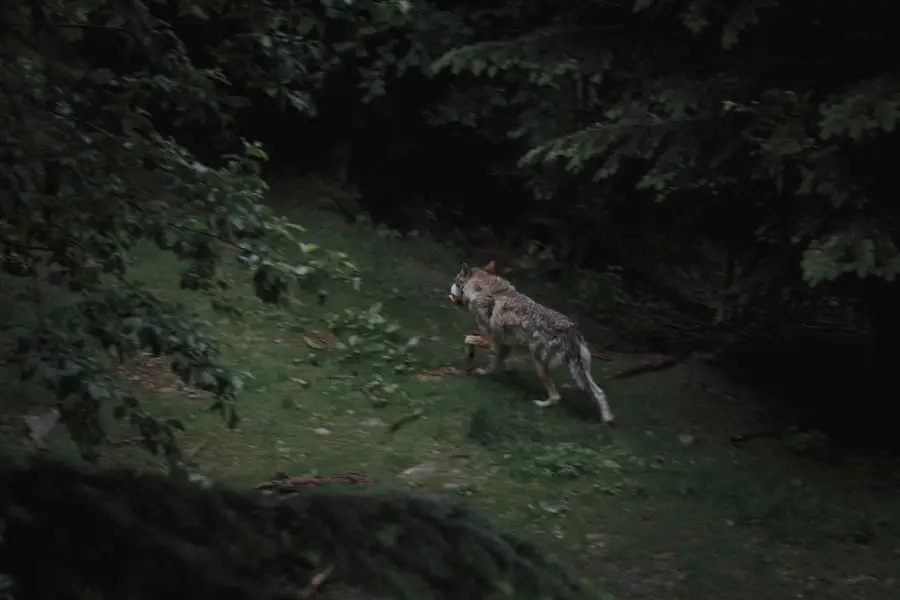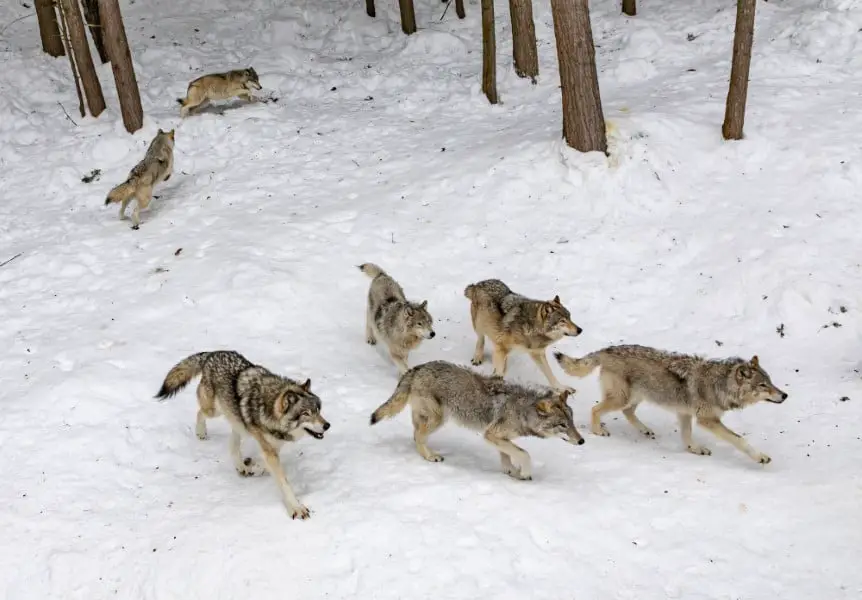Ever wondered what a wolf eats in the wild? Or a pack of wolves? What wolves predate on, during each time of the year?
In this article, we’re going to provide the full list of what a wolf eats, its complete diet, with facts and details.
But first, here’s a quick answer, then we’ll dive into more details…
What do wolves eat? During winter more deer are eaten by wolves. In spring the choices range more widely from large to small mammals, birds, and even fish. In summer wolves predate younger prey, and in autumn they often target salmon for nutrients.
Wolves eat for their survival of course and are mainly carnivores, but most nutritionists agree that a wolf’s diet consists of around 60% meat and 40% plant material. This varies according to seasons and other factors as mentioned above.
As wolves eat meat as their main food source, this means they need to hunt. Grey wolves hunt mostly large, hoofed animals.
These can include a variety of deer, moose, bison, elk, and mountain goats. They will even hunt smaller prey, such as hares, beavers, fish – and even birds.
Here’s what moose eat. Plus the difference between elk vs moose. Or did you ever wonder how fast a moose can run?
Wolf diet
While wolves are considered mainly carnivorous, they’re not completely carnivores.
Wolves are commonly known as carnivores because up to 60% of their diet consists of meat. But as we mentioned, the remaining 40% consists of an herbivorous diet, meaning they will eat plant-based material.
The reason why wolves tend to adopt a herbivore diet in parallel is that wolves have survived for thousands of years by being extremely adaptable to their surroundings.
Therefore, their diet has adapted to accommodate the different seasons, their changing environments, and therefore the availability of food.
To start with below is a breakdown of a wolf’s diet based on the season’s.

Wolf diet in winter
Winter can often either work out to be a favorable or unfavorable season for wolves and their diet. The favorability of the season depends on the snow conditions.
During slow snowfall, it becomes hard for wolves to catch whitetail hares, which is one of the wolves ’ primary sources of food. Whereas in heavy snowfalls with deep and crusted snow, deer become more vulnerable, giving the wolf a chance to feast during winter.
So in winter, the availability of food affects a wolf’s diet. Usually, a wolf ideally needs 2½ pounds of food every day for a complete diet.
To reproduce offspring, a female wolf needs about 7 pounds a day. But during winter, adult wolves have adapted themselves to survive without food for days and even weeks at a time.
Here’s where deer sleep to avoid predators like wolves.
Wolf diet in spring
Spring is a very prosperous season for wolves, because of the diversity of food available. In this season, a wolf’s diet consists of large mammals such as caribou, deer, and moose.
Apart from this, beavers are one of the staple food for wolves during this season, where beavers constitute 25-75% of a wolf’s diet in spring. Here when beavers are active.
Stacking up this diet, wolves also prey on vulnerable pups and young ones left in dens. This is also a season where wolves will feed on fruits, vegetables, and other plants if they feel they need to.
Even small mammals are a choice for wolves in this season. The idea behind such a versatile diet is to put on weight and to prepare for reproduction, as spring is the mating season for wolves.
So it’s very likely that wolves may even prey on small mammals such as mice, rabbits, squirrels, birds, snakes and lizards, insects, earthworms, snowshoe hare, pocket gophers, and voles.
And surprisingly, wolves do eat fish, however, fish and other unusual animals are consumed depending on the habitats wolves live in and their availability, of course.
Wolf diet in summer
This is the season of hunting for wolves. Most of the pups and young prey have grown to adulthood by summer, providing plenty of choices for wolves to hunt on.
Especially as beavers become fewer in population towards summer, so then ungulates make the bulk of a wolf’s summer diet.
However, hunting is the main source of food gathering during summer. It’s accounted for over a year a wolf can eat the equivalent of at least 15 to 19 adult-sized whitetails. And it’s also accounted that the wild population kills over 45,000 to 57,000 deer or more in a year in the U.S.
Of course, hunting is something of an artform for wolves, which we’ll discuss in detail below.
Wolf diet in fall
Winter is a season for the wolves to prepare for lying low over the winter period.
Wolves will try to put on weight as much as possible to survive winter, especially as wolves don’t hibernate. It’s believed that in autumn, wolves tend to prefer fishing overhunting.
Here’s a list of what animals do hibernate.
Although fall is a season of relative food scarcity and prey can be harder for wolves to find, they still have plenty of options to hunt on small animals.
However, it’s common for wolves to target salmon throughout autumn. Salmon in some areas can make up the majority of a wolf’s diet in the fall.
There are many reasons why wolves opt for salmon or fishing than hunting in autumn.
Firstly, Salmon provides enhanced nutrition in terms of fat and energy, which helps wolves to increase weight in preparation for winter.
Secondly, fishing takes up less energy than hunting, which helps wolves to save up energy for the winter.
Most importantly while hunting or certainly the wolf’s usual way of aggressive hunting, wolves are much likely to incur serious – and often fatal injuries.
And with winter approaching such wounds would result in a slower healing process, along with food scarcity and thereby risking the lives of wolves.
As such in autumn it’s said that wolves tend to fish salmon more often, than hunting, giving them a safer means of putting on weight and preparation for winter.
The seasons and the related diet patterns of wolves show how important hunting is for a wolf’s diet. So this might be a good point to talk about the art of a wolf’s hunting.
How wolves hunt for their food
The skill of a wolf’s when hunting comes as a pack – collectively.
wolves can hunt alone, in fact, they could hunt a moose all by themselves if they had to. but hunting with a pack is really the most natural way for a wolf to hunt.
Since wolves prefer large mammals, hunting them collectively as a pack is far more effective.

One interesting fact about wolves is that they do not return to the carcass of the animals they hunt and kill, and so they do not cover or hide the carcass for a later time.
The hunting pattern – or strategy, for a wolf, differs from one prey to another, especially depending on whether the prey is likely to fight back or attack.
These patterns are more like strategies to avoid harming themselves. For example, a large deer will be hunted from behind, this strategy is to avoid getting attacked by its forehooves.
Even while attacking a deer, a relative distance is maintained away from its hooves. Whereas, when it comes to small prey wolves will happily attack from the front, usually aiming for the neck area.
Once after hunting, the wolf will start eating the prey from the opening of the bitten area/wound.
Even if the prey is hunted in a pack and eventually brought down, none of the pack is allowed to eat any of the prey until the alpha male and his female have had their turn. This cements part of the order within a wolf pack.
If the prey is hunted as a pack, and the alpha pair have eaten, then the remainder of the pack will be allowed to feed on the same animal, this can then become quite chaotic.
Usually, wolves will eat the entire animal and will even continue to chew the bones if they’re not fully satisfied.
To identify a wolf pack attack from a dog pack attack, one would only be able to tell by closely observing bite marks and wound sizes. A wolf bite is deeper and more powerful, teeth marks will be longer and wider, and bite wounds will be broader.
It should also be said that in most cases, protein-rich organ meat is the first part the wolf eats, followed by ribs and even the lining of the stomach. In rare cases, pieces of muscles are eaten and bones are partially consumed.
Only a partial consumption of prey is taken when wolves have an abundant supply of food sources, usually in spring and summer, so they eat only the high-quality parts, leaving out the rest – or certainly the least quality choice parts.
Whereas in winter and autumn, when prey is scarce, wolves opt to eat pretty much everything and sometimes even the bones and other low-quality bits and scraps.
Fruits and vegetables in a wolf’s diet
Although it’s not exactly clear what vegetables wolves eat, wolves do chew on grass as an herbivorous part of their diet.
Much like cats and dogs, wolves eat grass after eating something that doesn’t agree with them. The grass is consumed as a way of clearing their digestive system.
So wolves tend to eat grass when they face gastrointestinal issues including upset stomach, nausea, bloating, and illness from pathogenic microbes.
The theory behind eating grass is that grass will cause gastric irritation that can lead to vomiting, which can help purge their digestive system.
also, wolves are known to enjoy a selection of fruits ranging from blueberries, cowberries, apples, and pears.
Vitamins and nutrients in a wolf’s diet
With a majority of a wolf’s diet made up of prey, organs such as lungs, liver, heart, and kidneys are given importance, which is high in B vitamins, vitamin A, minerals, and fatty acids that are required for maintenance, growth, and reproduction.
On average, a wolf’s diet consists of a whopping 49% protein, 44% fat, and 6% carbohydrate, resultant in consuming 85% to 90% meat.
Learning resources
We’ve found the ideal resources to continue your learning at home and at school on amazon. Help support our efforts for wildlife causes and keep this site working for nature. Amazon also donates to Wild-life related charities!
The Hidden Life of Wolves
Wolves: Behavior, Ecology, and Conservation
Video resources
Related articles
What Eats a Wolf – What Animals Eat Wolves – List of Wolf Predators?
Where Do Timberwolves Live, In the World, Which Habitats
20 Quick Facts About Arctic Wolves for Kids and Adults
So to finish…
We hope this has been helpful in understanding what a wolf eats during the various times of the year. Be sure to check out our other wolf-related articles and other interesting wildlife content on the site.
This content has been checked and verified by a qualified veterinary practitioner. The article has been reviewed by our editorial board and has been approved for publication in accordance with our editorial policy.
